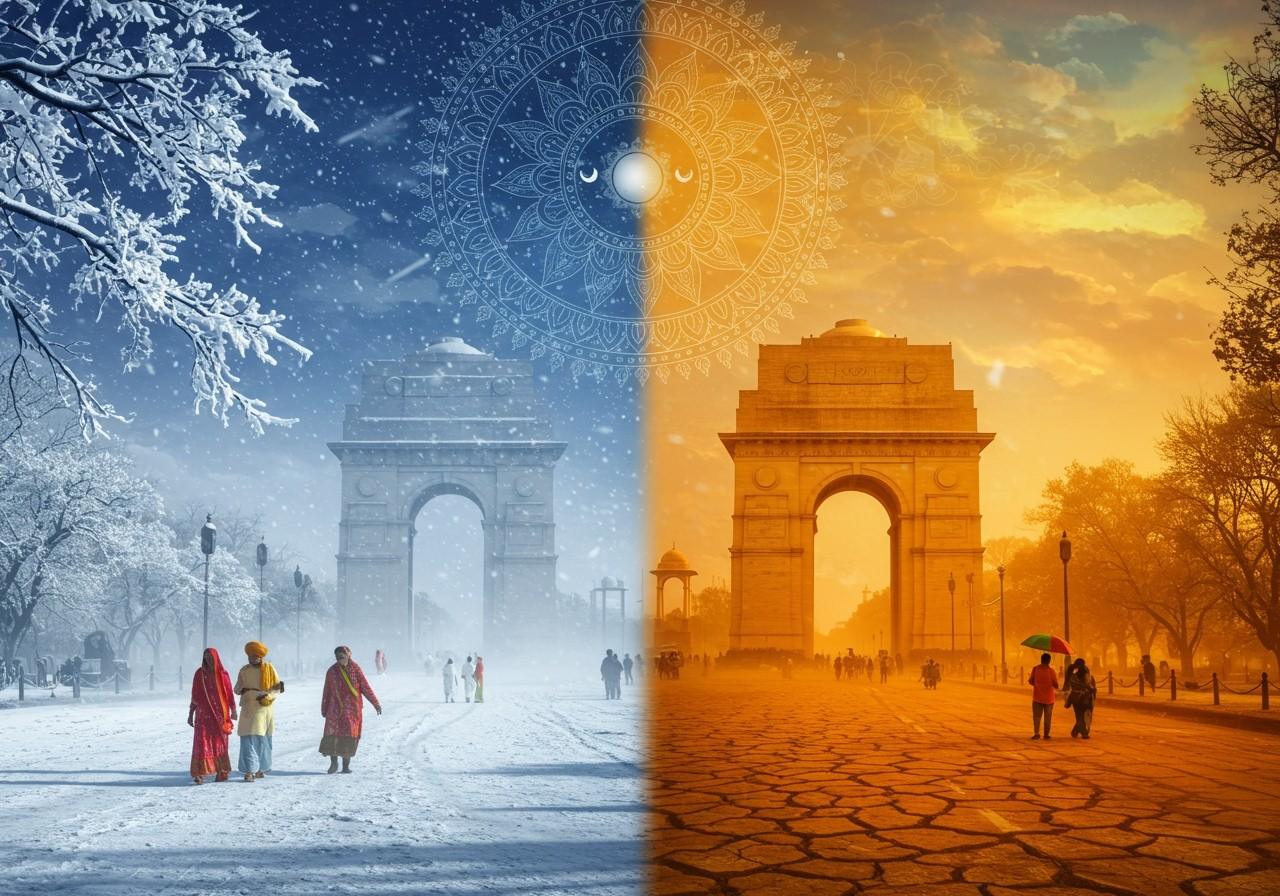
North India is known for its diverse climate, experiencing everything from frigid cold waves to scorching heat waves. This article delves into the factors behind these weather extremes, exploring the geographical, meteorological, and seasonal influences that shape this region’s unique climate patterns. Recent reports highlight the severity of these conditions, with heavy rain, thunderstorms, and heatwaves impacting the region. Himachal Pradesh experienced a tragic fatality due to a falling tree during a hailstorm, while Rajasthan and Uttar Pradesh are grappling with temperatures reaching 45 degrees Celsius. The Indian Meteorological Department has issued alerts, urging people to take precautions.
Geographical Influences
The Himalayas play a crucial role in North India’s climate, acting as a barrier against cold Arctic winds, contributing to cold waves. Conversely, the flat Indo-Gangetic Plain experiences high summer temperatures, leading to heat waves. Higher altitudes, like in Himachal Pradesh, have colder climates, while the proximity to the Thar Desert contributes to arid conditions and extreme heat. Northern rivers, such as the Ganges, moderate local climates. Urbanization also impacts microclimates, particularly in cities like Delhi and Lucknow.
Meteorological Factors
Several meteorological factors contribute to North India’s weather extremes. Western Disturbances, bringing cold air and precipitation from the Mediterranean, affect the region, particularly during winter. Monsoon patterns are critical; delayed or weak monsoons can exacerbate heat waves, as seen in Uttar Pradesh. Jet streams bring cold air from polar regions in winter, leading to sudden temperature drops. El Niño and La Niña influence seasonal weather patterns, affecting rainfall and temperatures. Cyclones can also impact coastal areas. Furthermore, global warming intensifies the frequency and intensity of these weather extremes.
Seasonal Variations
North India’s climate experiences distinct seasonal changes. Winter brings low temperatures and fog, impacting daily life and transportation. Spring offers a brief respite with rising temperatures and occasional rain. Summer is characterized by extreme heat and dry conditions, with temperatures soaring as high as 45 degrees Celsius in regions like Rajasthan and Uttar Pradesh. The monsoon season brings vital rainfall and cooler temperatures, crucial for agriculture. Post-monsoon, or autumn, has mild temperatures and reduced humidity.
Historical Climate Trends
Examining historical climate trends provides valuable insights into current patterns. Records of temperature and precipitation in North India reveal trends in the frequency and intensity of cold waves over time. Heat waves have become more frequent, impacting health and agriculture. Changes in monsoon patterns, including onset, duration, and rainfall amounts, are evident. Historical events like droughts and floods have shaped the region’s resilience to climate extremes. Traditional knowledge and practices have played a role in helping communities cope with these challenges.
Impact on Daily Life and Economy
Extreme weather significantly impacts daily life and the economy. Cold waves can lead to respiratory issues and hypothermia. Heat waves cause heatstroke and dehydration, particularly with temperatures reaching 45 degrees Celsius in areas like Rajasthan and Uttar Pradesh. Agriculture suffers as extreme weather affects crop yields. Infrastructure, including roads and rail transport, faces disruptions. Increased energy consumption for heating and cooling strains the economy. Government policies and initiatives, such as alert systems and disaster preparedness plans, are essential for mitigating these impacts.
Poojn.in: Your Companion Through Weather Changes
Poojn.in offers a range of products to help you maintain your spiritual practices throughout North India’s varying weather conditions. With recent weather events impacting the region, it’s more important than ever to be prepared.
- Winter Puja Needs:
- Brass and copper oil lamps maintain a steady flame even in cold drafts, ensuring your prayers are undisturbed.
- Weather-resistant agarbatti stands prevent damage and ensure continuous use throughout the season.
- Summer Worship:
- Copper kalash keep water cool, essential for maintaining hydration during hot weather and for traditional rituals.
- Heat-resistant puja mats provide comfort during extended prayers, even in high temperatures.
- All-Weather Essentials:
- Weather-proof puja storage boxes protect your sacred items from moisture and temperature fluctuations.
- All-season dhoop and agarbatti varieties offer a fragrant experience regardless of the weather, enhancing your spiritual practice.
Visit www.poojn.in for a complete selection of weather-appropriate puja items. We offer pan-India delivery with secure packaging to safeguard your purchases from weather-related damage during transit.
Conclusion
North India’s climate is a complex interplay of geographical, meteorological, and seasonal factors. Understanding these elements provides insights into the challenges and resilience of the region’s inhabitants. From cold waves to heat waves, the climate shapes daily life, agriculture, and the economy. By acknowledging these factors and promoting awareness, we can contribute to better preparedness and support for those affected by extreme weather, ensuring the preservation of traditions and livelihoods in this vibrant region.
FAQs
Why is North India cold during winter? The Himalayas block cold winds from Central Asia, leading to cold waves.
Why does North India experience extreme heat during summer? The region’s distance from the sea results in less moisture and more direct sunlight, causing extreme heat.
What causes cold waves in North India? Cold winds descending from the Himalayas cause significant temperature drops, leading to cold waves.


